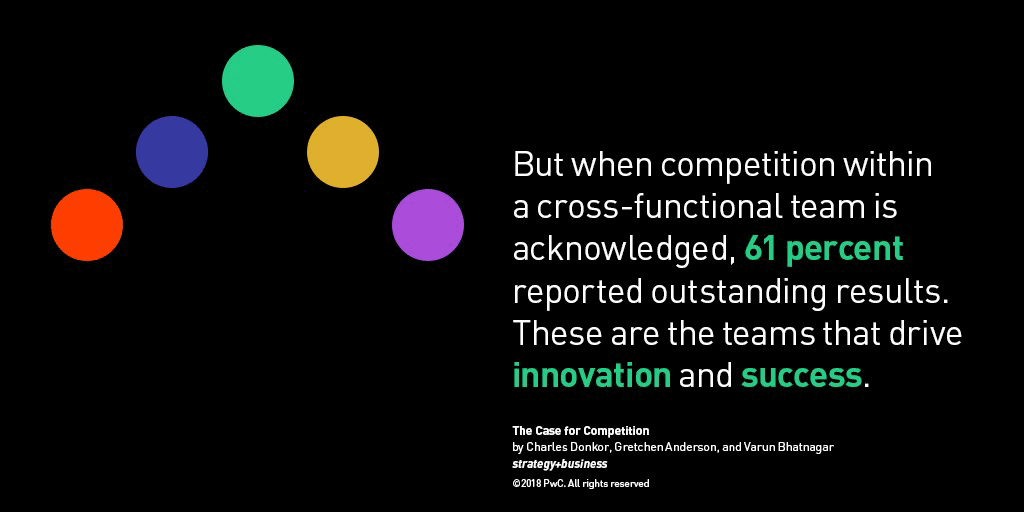The Case for Competition
When team members face off, it’s the whole organization that wins.
In 2017, the telecommunications industry underwent intense consolidation. The leadership’s nerves were fraying at one leading European telecom, and a team of advisors was called in (some of us among them) to improve the organization’s overall effectiveness.
At the project kickoff meeting, sidelong glances and cleared throats signaled to us that there was skepticism surrounding this topic, something below the surface that wasn’t being said. Finally, with prodding, we were able to get one of the leadership team members to open up.
“I’m just not that sure that we can all get together and talk about teaming without acknowledging something: We are all deeply, deeply competitive,” he said. “And I don’t think that’s going to go away.”



One advisor — Charles Donkor, one of this article’s authors — nodded, curious to see whether the rest of the group would dive in. He’d already noticed that rivalry was intense in this team, both within its ranks and with the other groups with which it interacted. A few of the executive leadership team members had acknowledged this in earlier interviews, but it had not yet been spoken in the room, within earshot of their peers. They all looked to Donkor.
“What if that isn’t a bad thing?” he asked. “What if we could actually name and acknowledge it — could we work with it, and find some ways to harness it for good?”
Some looked dubious; others intrigued. But a door had been opened, and what came next ushered in a new era for this company’s leadership team and their ability to compete and cooperate in tandem.
An Unlikely Discovery
Difficulty building and working in effective teams is not uncommon. Though the idea of teaming is increasingly recognized as important to the success of an organization, it can still be full of pitfalls.
Our studies show that teaming is hard work and that the aspiration of what a team could or should do often far exceeds what a team actually manages to accomplish. In one of our studies, less than half (41 percent) of respondents agreed with the statement that their team often produced outstanding results. And when teams are made up of cross-functional members, which has become the norm for how work gets done, that number drops even lower, to 36 percent. Further, when asked directly whether it’s possible or easy for an individual to work effectively across functions, only a tiny number of respondents called the process easy (14 percent).
But here’s our unlikely discovery. When the element of competition — in this case, a drive to prove one’s point and challenge the points of others — is present, alive, and acknowledged within a team, that team is more empowered, more connected, and more likely to work together effectively.
When we think of effective teaming, we often think of collaboration. But consider the possibility that an element that is much harder to acknowledge and address — an element that sometimes, in a room, can feel like a dirty word — may be much more helpful and effective in getting team members with disparate points of view to achieve something truly extraordinary.
Three Reasons to Compete
When competition is acknowledged and leveraged correctly, your team can be positively impacted in three ways.
Challenging viewpoints. In 1962, John F. Kennedy’s administration faced the terrifying, world-holding-its-breath threat of the Cuban missile crisis, a 13-day confrontation between the United States and the Soviet Union. From the perspective of the U.S. leaders, there were two potential responses: a military strike or a naval blockade. Stakes for this decision could not have been higher. Historians acknowledge this moment in the Cold War as precipitously close to escalation into a full-scale nuclear war. The decision at which Kennedy and his advisors arrived — the naval blockade — is now acknowledged as one that successfully ended the crisis.
But just a year earlier, with the Bay of Pigs invasion, Kennedy and this same administration, which included many of the same leaders, did not succeed. Why? What’s the success-making difference between these stories?
With the Bay of Pigs, the decision to send a covert team to Cuba to overthrow Fidel Castro was backed by the CIA. Major obstacles were identified, and various perspectives were solicited, but the competitive spirit just wasn’t there — the pervading culture was such that team members deferred to the CIA. The mission failed.
However, when this team was faced with the Cuban missile crisis in the next year, the advising team started to compete: Each camp (the military strike camp and the naval blockade camp) wrote a position paper explaining their arguments. The papers were then swapped and subjected to criticism by the other side.
By fostering constructive competition through this large-scale debate between supporters of the two options, Kennedy enabled both sides to think deeply and communicate effectively about why their opinion was right, giving Kennedy the appropriate knowledge he needed from his advisors to make the decision that would successfully end the crisis.
Although you might not be on a team that is solving world crises, competition can encourage and enable team members to challenge and think more deeply about preexisting viewpoints that, if left unchecked, could prove disastrous for the execution of your organization’s strategy.
Generating ideas. Another reason to compete has to do with innovation. Electronics giant Samsung uses competition as a vehicle to take its business to new heights, injecting doses of competitive spirit into its existing highly collaborative culture. Historically, the company has placed a great deal of emphasis on collaboration among its businesses, derived from the enterprise’s strong sense of a single group identity with an integrated set of values across its affiliates.
Competition can encourage and enable team members to challenge, and think more deeply about, preexisting viewpoints.
As part of its effort to make its businesses more competitive in the electronics market, however, Samsung now practices “parallel development,” in which different teams across the organization’s multiple affiliates may be working on similar projects. Rather than rationalize the development effort to just one team, the firm encourages teams to compete.
Multiple labs are given the same mission, after which the buyer business unit selects the team with the best proposal or technology and instructs it to proceed with development and implementation. Winning teams are often well compensated for their work, promoting creative and innovative solutions to beat out both internal and external competition.
At the end of these competitions, Samsung brings all the involved labs into an overall cross-functional team, in which members share the unique solutions that each lab proffered. The competition is a win-win for the enterprise — creativity flourishes, and the resulting product ideas could generate new revenue streams for the organization overall.
In fact, the innovative solutions from Samsung’s parallel development of its OLED (organic light-emitting diode) technology led to the creation of an entirely new business unit called Samsung Mobile Display, which became successful in the OLED market thanks to its combination of technological and manufacturing expertise.
Fomenting commitment. We return here to the story of the European telecom. Recall that the competition was there — but what Donkor helped the team do was name it, and work within it rather than against it to achieve their goals.
Competition can lead to great things, as seen in the aforementioned situations. But when competition is not acknowledged, accepted, and intentionally incorporated into a team’s way of working, it can have damaging effects on a team’s commitment to achieving its set goals.
As Adam Kahane writes in “Why Teams Should Argue,” leaders and team members often think that to make progress they need to “ignore, avoid, or smother conflicts: to be polite and to paper over our differences.” When we are concerned that our reputations, careers, and even feelings will be hurt, this mind-set makes useful collaboration all but impossible. Attempting to gloss over differences in teammates’ perspectives, interests, and needs won’t make them disappear. They will “fester and erupt later with greater violence.”
To address this concern, teams should agree upon a set of guiding behaviors that will harness the competition inherent in the organization’s culture as a tool to reinforce team commitment, rather than pull team members apart. In the case of the European telecom, the credo set forth by the company was as follows:
- Speak bluntly.
- Don’t escalate an issue before you have a one-on-one with the person it concerns.
- Support others, but also challenge them.
To ensure these principles were being adhered to, the team also agreed to have periodic check-ins in which they would engage in frank discussions about how these guiding behaviors were influencing (or not influencing) day-to-day team interactions.
The result of this intentional focus on healthy competition was an increase in trust. By bringing the competitive culture out in the open, team members felt they could be open about their personal goals, too. This willingness to be vulnerable deepened relationships and created a safe place in which team members could truly be honest with one another.
It’s a powerful reminder of how difficult it can be for any team to acknowledge competition as an effective force. In our previously mentioned study, less than half (45 percent) of survey respondents believed that competition was a positive force for their organization. However, among respondents with highly effective teams, 65 percent indicated the presence of both competitive and collaborative forces within their teams. And among this group, 65 percent also had a positive view of competition — that’s 20 percent more than the general population.
A Powerful Tool
In today’s environment of continuous innovation, effective teams can be the key to finding the opportunities that help organizations stand out from the ever-expanding crowd. However, putting words to action is not easy; many organizations have traditionally struggled to leverage the full potential of their teams.
The intuitive response to struggling teams and counterproductive dynamics is to find ways to simply “collaborate better.” The implication of this kind of imperative is that a team would be more effective if the members could simply be the best version of themselves — kinder, more appreciative of others, more willing to hear others’ point of view. But what if it isn’t so simple? What if our aggressiveness, our desire to beat out our peers for top roles, could also be acknowledged as part of the mix? Our research and experience shows this as a positive. Being honest about behaviors that can be construed as negative is an integral part of what makes a team effective.
No organization’s culture is entirely good or bad. What’s important is to make use of a culture’s inherent strengths.
We’ve seen how this tool can help us challenge existing ideas and enhance creative thought. When used skillfully, competition has the power to change this dynamic, helping yield major returns for both your teams and your organization.
Author profiles:
- Charles Donkor is a partner with PwC Switzerland. Based in Zurich, he advises clients on culture transformation and people topics with a focus on change management and HR strategy.
- Gretchen Anderson is a director at the Katzenbach Center, PwC’s global institute on organizational culture and leadership. Based in New York, she is coauthor, with Jon Katzenbach, of The Critical Few, a book on organizational culture to be published in 2019.
- Varun Bhatnagar advises clients on culture and organization for Strategy&, PwC's strategy consulting group. An associate with PwC US based in Dallas, he is a 2018 fellow at the Katzenbach Center.


